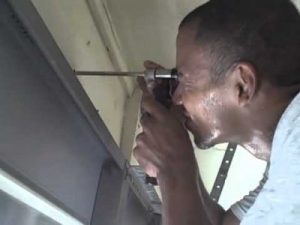
People have came up with many ways of pest-control. Some of them are very effective and popular, while some a for users on budget.
Some may be made yourself, or otherwise called do-it-yourself methods, while some can only be used by professionals.
There’s a vast choice when It comes to controlling the parasites around your home. Some are used in combination with others.
Like baits (stake ones), or repellents, maybe even spot treating. And drilling holes into the ground and/or the walls. So let’s see what this method has to offer.
Hide content
- Pros and cons
- How to drill holes for termite treatment?
- Effective or not?
- Useful articles
- Helpful video
- Conclusion
Be careful: even though there’s going to be a lot of information in this article, it’s still better to consult pest-control specialists before doing anything, for your and your households sake. This way you will certainly eliminate any misunderstandings and as such, eliminate the termites. And definitely you won’t make any regrettable mistakes afterwards. It isn’t hard to ask for specialists’ help.Pros and cons
So, drilling holes is something you are interested in. When termite treatment drilling should be used and why?
So, one of the most notable reasons for you to drill holes, is to insert repellents and/or baits inside the ground or your house’s wooden walls.
And is it effective to drill holes in your house? Absolutely. In fact, it is one of the most popular ways of temporarily (or for one-time use) defending a wooden construction from termites.
In the first case, the holes are drilled and the insecticide is poured inside to prevent further infestations and completely stop termites from appearing.
In the seconds case, you drill holes into or close to the nests, apply an active insecticide and that way you get rid of the nest immediately. Both are very effective ways of pest-control used world-wide. On the negative side, well, you have to drill holes.
They may ruin the looks, structural integrity and else. Secondly, if using for eliminating an existing nest, you need to surely identify where to drill. If you don’t do that, then your effort would be ignored by those cheeky termites, and they will just continue to multiply inside your walls.
Also, this method is not your variant if you are going for do-it-yourself pest-control. The problem is simple: you can’t identify the nest without great experience in the subject and knowledge. So, as always, be sure to contact your local pest-control service.Nonetheless – it’s still better then failing horribly and making everything even worse. For example, if you don’t identify the nest correctly and disturb the termites, they might move to a different place inside your house.
Also, as you might have guessed, the method is most often used for wooden termites – though that doesn’t mean it is always used for them. When it comes to subterranean termites, specialists or you have to drill holes into the base of the house.
Here you can learn more information about effective termite control remedies: Bora-Care, Boric acid, Borate, Fipronil, Chlorpyrifos, Chlordane, Borax, Timbor, Termidor, Terminator, Phantom, Lorsban, Biflex, Terro. You can choose different forms, such as – foam, liquid, powder.
How to drill holes for termite treatment?
Drilling holes termite controll in the first place is simple. You should use a drill with a fitting head.
For example, if drilling through wood – use something lighter and softer, otherwise, while drilling through materials like concrete, be sure to use something more serious, and a more serious drill if required.
Let’s say you know the termites reside, and where is their nest.
You’ve chosen an appropriate instrument and are ready to go. What should you do? The following process is for when you drill trough cement base of the house.
Mark the spot(s) where you are going to drill. We recommend you to try and surround the nest, and not drill into it if you know the exact position. A couple or a triple of holes for a small nest would be enough. This number increases the larger the nest is.
When the spots are marked, go on and drill. Be accurate, don’t drill to deep not to disturb the termites too much. Be sure to wear all the required equipment as well if you are afraid of something going wrong.
Warning: please, for the following step be sure to wear gloves. You are dealing with chemicals here, and they may cause many problems if not managed correctly. Including the skin irritation, and spreading to all the things you could touch with your bare, covered in toxic material, hands.When the holes are done, you should go on and fill them up with a chosen insecticide. Liquid and dust pesticides will work just fine. Be sure to not fill too much inside, or otherwise a lot of substance may be wasted. or this step please be sure to wear gloves. You are dealing with chemicals here, and they may cause some problems if not managed correctly.
After everything has been filled, brush the edges of the hole (still wearing gloves) and use caulk pistol to fill in the end of the hole, until you see it starting to overfill. The overfilled part of caulk should be removed for aesthetics.
You are done unless there are any holes left. They need to be filled up the same way.
Here you can learn more information about termite bait systems: Advance, Green, CSIRO, Nemesis, Exterra, Firstline, Terminate. Also find out how to make baits by yourself and how to refill them?
Effective or not?
If you would ask a professional the question above, then the answer would be: “Yes, yes of course!” Indeed, mostly, the further you go in pest-control, the better. In our case, we are going so far, that we are even drilling holes in the house!
You are transporting the insecticide right into the termites’ habitat, there’s not many thing more effective than that.
Though the speed of the progress still depends on your or the specialist’s skill.
The second one should rarely be asked, but your’s one can play big role in the eradication of termites.
Let’s say you’ve done everything as good as possible, poured the insecticide as perfectly as possible etc. The answer would be: soon.
In fact, very soon. Termites will receive a fatal dose of toxic materials, and in a matter of weeks, if not days, will be gone completely. If you put this in comparison with other pest-control methods, for example, a well known DIY stakes baiting system.
The said system will deal with a small amount of termites in around 6 to 9 months. And we are comparing it with less than a month. So, again, the method is much more effective than many other methods, and that is why it is a beloved method for all the pest-control firms out there.Here you can learn more information about effective treatment method called tenting (fumigation): dangers for termites, preparing for fumigation and cleaning after, how long does this procedure last?
Useful articles
If you interested in more information of termites we recommend you to read the following articles:
- All types of termites. Are they harmful to humans? Can they bite you? And what is the difference between drywood and subterranean ones?
- What does swarmers of different species look like: drywood, subterranean, formosan?
- Signs of infestation outside and in the house: in walls or furniture.
- How to treat them at home and in the yard: in wood or in fence. How long this process lasts and what is pre-construction and soil treatment?
- What does termite holes look like? What is droppings and is it toxic to humans? Do termites make noises?
- Posible termite damage, how does it look like? Examples of damage in walls and wood floors.
- All about flying termites: how do they look like, swarming season and what to do if there are swarmers in your house?
- How do they do nests and mounds? How to find it in your garden or inside the house?
- Termite life cycle – from egg to larvae. And social hierarchy: workers, soldiers, queen.
- Did you know that termites can infest living trees, for example a palm or a pine tree. They also like to live in stumps.
- You can prevent the infestation by using barriers, such as: HomeGuard, Physical systems, Safeguard, Stainless steel mesh, Kordon.
- If you want to get rid of termites naturally, learn more about such methods as: heat or cold treatment, orange oil, using nematodes.
Helpful video
This video show termite treatment drilling holes in concrete around a home for subterranean termites:
Conclusion
All in all, drilling holes in your building, especially if you have an ongoing infestation should be done with care. You don’t want to fail and re-drill a hole, do you?
Still, all thing considered, the method you’ve just read about is a really good and effective way and can not only be used for removing the currently existing nests, but, as it has already been stated above, for preventing the house from the future infestations.
Also, unlike other methods used by pest-control companies, this one won’t cost you that much – not that it will be dirt cheap.
All the specialist services can be quite expensive, as much as they are effective. So, definitely look into this method and see if it fits you well.
There are just too many positive sides to it, not considering how universal it may be. But if you don’t think the method will be fitting for you, or just want something that can be done on your own, we advice you to choose something quite close to hole-drilling.
And that is, professional baiting systems (not stake baits). They can be installed around the house at any time, though they are not as effective as the method we discussed above. Nonetheless, it may fit your circumstances. Good luck with your choice, and thank you for reading!

